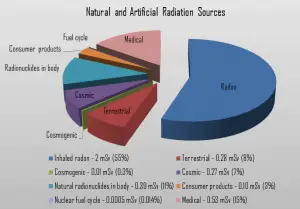 Radiation is all around us. In, around, and above the world we live in. It is a natural energy force that surrounds us. It is a part of our natural world that has been here since the birth of our planet. All living creatures, from the beginning of time, have been, and are still being, exposed to ionizing radiation. Ionizing radiation is generated through nuclear reactions, nuclear decay, by very high temperature, or via acceleration of charged particles in electromagnetic fields.
Radiation is all around us. In, around, and above the world we live in. It is a natural energy force that surrounds us. It is a part of our natural world that has been here since the birth of our planet. All living creatures, from the beginning of time, have been, and are still being, exposed to ionizing radiation. Ionizing radiation is generated through nuclear reactions, nuclear decay, by very high temperature, or via acceleration of charged particles in electromagnetic fields.
Coal Ash – Fly Ash as Radiation Source
According to the UNSCEAR, power generation from coal and entire coal cycle contribute more than half of the total radiation dose to the global population from electricity generation. This statement will seem paradoxical to many readers, since it’s not commonly known that non-nuclear energy sources release any radiation into the environment. But power generation from coal also creates additional exposures to public. Even nuclear fuel cycle releases less radiation into the environment than coal cycle and any other major energy source.
The problem is coal itself and especially coal ash (fly ash). Coal, a combustible black or brownish-black sedimentary rock, contains a substantial amount of the radioactive elements uranium and thorium. According to the UNSCEAR, the average specific activity of both uranium-238 and thorium-232 in coal is generally around 20 Bq/kg (range 5-300 Bq/kg). Coal mines in Freital, Germany, which have uranium concentrations of 15000 Bq/kg coal, are an exception. Burning coal gasifies its organic materials, concentrating its inorganic components into the remaining waste, called fly ash. Around 10% of coal is fly ash. Fly ash is hazardous and toxic to human beings and some other living things, and fly ash also contains the radioactive elements uranium and thorium, which are concentrated by a factor of 10. It must be emphasized, even fly ash does not possess any health hazards to the public. There are a few restrictions on the use of fly ash in landfill and road construction. Most restrictions are on the use in building construction, where it can result in increased exposures especially from radon. In any case, we don’t want to cause any irrational fear of radiation from coal. It does not mean, that it must be dangerous. In case of radiation from electricity generation, the doses are usually very, very low. Moreover, these results cannot be used to determine whether one form of energy generation is preferable to another.
The collective dose, which results from coal cycle is:
- 670-1400 man Sv for coal cycle, depending on the age of the power plant,
When considering the amount of electricity generated in the year 2010 by each technology, the coal cycle resulted in the largest collective dose to the global public and workers combined, followed by the nuclear fuel cycle. Of the remaining technologies, geothermal energy and combustion of natural gas were the next largest contributors.
The normalized collective dose (per gigawatt and year) is:
- 0.7 – 1.4 man Sv/GW.a (man sievert per gigawatt year) for coal cycle
Special Reference: Sources and effects of ionizing radiation, UNSCEAR 2016 – Annex B. New York, 2017. ISBN: 978-92-1-142316-7.
In the following points we try to express ranges of radiation exposure from electricity generation together with doses from, which can be obtained from various sources.
- 05 µSv – Sleeping next to someone
- 09 µSv – Living within 30 miles of a nuclear power plant for a year
- 1 µSv – Eating one banana
- 3 µSv – Living within 50 miles of a coal power plant for a year
- 10 µSv – Average daily dose received from natural background
The above doses are related to public exposure. If we consider occupational exposure, regarding the coal mining and fly ash deposits, the collective dose is higher especially for coal miners. Coal miners as a group receive the largest collective dose of radiation, through enhanced exposure to naturally occurring radionuclides.
Note that, the collective effective dose is often used to estimate the total health effects, but according to the ICRP this should be avoided (see more: Collective Dose).
We hope, this article, Coal Ash – Fly Ash as Radiation Source, helps you. If so, give us a like in the sidebar. Main purpose of this website is to help the public to learn some interesting and important information about radiation and dosimeters.